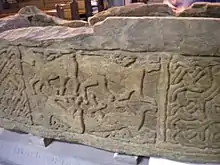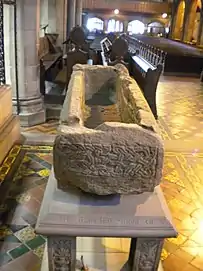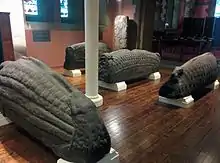The Govan Stones
The Govan Stones are early medieval carved stones displayed at the Govan Old Parish Church in Glasgow, Scotland.[1]
 Govan hogback stone at Govan Old Parish Church | |
| Location | Govan |
|---|---|
| Coordinates | 55.8646°N 4.3129°W |
Description

The stones are thought to have been created to commemorate the power and wealth of the rulers of the lost Kingdom of Strathclyde.[1] Forty-five stones existed as late as the 1980s. However, many were destroyed when the neighbouring Harland and Wolff shipyard was demolished in 1973[2][3] and the stones were mistaken for debris. One was rediscovered by a fourteen-year-old schoolboy in 2019, working as part of a ‘Stones and Bones’ archaeology and heritage programme, prompting hopes that more of the stones had survived.[4][5]
The remaining stones are a sarcophagus, five hogback stones and thirty-one recumbent gravestones.[3] Each stone weighs half a ton.[3] and is carved with elaborate designs of carved crosses and cross shafts.[6]

The centrepiece of the collection is the sarcophagus, which is thought to commemorate St. Constantine,[7] the son of Pictish king Kenneth MacAlpin.[2] It features carvings of hunting scenes and warrior figures. Carved from solid stone, the sarcophagus is the only one of its kind from pre-Norman, Northern Britain.[6]
History
The stones have been dated back to the 9th–11th centuries when the Vikings raided the Clyde region. The Vikings destroyed Dumbarton, at the mouth of the Clyde, in 870 AD. This fortress, known as Alt Clut, was the centre of an ancient kingdom of Britons.[8] With the king of Alt Clut, Artgal, either killed or enslaved by the Vikings,[8] Govan, further up the river, gained great strategic importance as a new dynasty was established in the Kingdom of Strathclyde. Govan Parish Church became an important ecclesiastical centre for this new kingdom.[2][9]
The presence of the five hogback stones in Govan suggests the area was settled, or at least partly settled, by Vikings.[10] These large sandstone blocks were found exclusively in areas of Northern Britain where the Vikings settled and were used to make tombs look like mighty buildings in the Norse style.[2] Nowhere else are there hogback stones quite as large as the five in Govan.[9]

"It underpins this idea that this British kingdom of Strathclyde has some strong connections with the Scandinavian world. My feeling is that this is meant to represent a lord's hall or a chieftain's hall." - Stephen Driscoll, professor of historical archaeology at Glasgow University.[2]
The sarcophagus was discovered in the graveyard in 1855 when a grave was being dug to the south east of the church.[9] Recognising their significance and to protect the stones from the elements, they were moved from the surrounding graveyard and placed on display within the church itself in 1926.[9] Until that point, the stones had lain undisturbed for over a thousand years.
Scotland's hidden gems
The British Museum affirmed the importance of the collection when they took one of the hogback stones to London as part of the exhibition Vikings: Life and Legend (March 2014 to June 2014).[11][12] In August 2017, the Govan Stones were voted Scotland's best 'hidden gem' in a nationwide competition,[13] receiving more than two thousand votes in the nationwide poll.[10] They have been described as of international significance.[4]
References
- "The Govan Stones | Get Into Govan". www.getintogovan.com. Retrieved 2017-10-06.
- Brocklehurst, Steven (2014). "The hidden Viking-Age treasures of Govan". BBC News. Retrieved 2017-10-06.
- "Govan viking hogback gravestone stones where to stay". www.iknow-uk.com. Retrieved 2017-10-06.
- "Schoolboy finds lost piece of Glasgow's Govan Stones". BBC News. 29 March 2019. Retrieved 6 April 2019.
- Rogers, James (2019-03-29). "Schoolboy discovers long-lost 1,000-year old stone monuments from ancient kingdom". Fox News. Retrieved 2020-09-11.
- Maltby, Ingrid Shearer, Steve Driscoll, Chris Tuckley, Sarah (2012-03-25). "The Govan Stones". www.thegovanstones.org.uk. Retrieved 2017-10-06.
- "Happy to read all about the Govan Stones". HeraldScotland. Retrieved 2017-10-06.
- "Book review: 'Strathclyde and the Anglo-Saxons in the Viking Age' by Tim Clarkson". The Hazel Tree. 2015-01-23. Retrieved 2017-10-06.
- info@undiscoveredscotland.co.uk, Undiscovered Scotland. "The Govan Stones Feature Page on Undiscovered Scotland". www.undiscoveredscotland.co.uk. Retrieved 2017-10-06.
- McCall, Chris (1 August 2017). "Scotland's top six historical 'hidden gems' revealed". www.scotsman.com. Retrieved 2017-10-06.
- "Govan Stones: Historic Hogback Stone leaves Scotland for first time in". The Independent. 2014-01-27. Retrieved 2017-10-07.
- Coffey, Sally (2014-01-30). "The Govan Stones: Scotland's best-kept medieval secret". Britain Magazine | The official magazine of Visit Britain | Best of British History, Royal Family,Travel and Culture. Retrieved 2017-10-06.
- Speirs, Kathleen (2017-08-01). "Govan Stones dubbed Scotland's top hidden gem". glasgowlive. Retrieved 2017-10-06.
